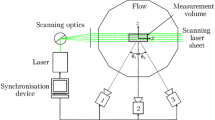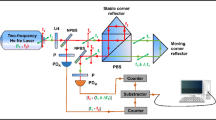Abstract
In order to minimize damage to the surface being measured and improve measurement speed, laser triangulation technique has been widely employed in various ultra-precision manufacturing processes and precision instruments. However, several factors such as ambient light interference, scattering of particles in the measuring medium, surface roughness, inclination, and movement of the target surface collectively influence the measurement accuracy of laser triangulation. Therefore, it is crucial to establish an error model and compensate for the measurement errors. This paper investigates the individual and coupled effects of these factors on measurement errors, and based on this analysis, proposes an integrated error model that enables higher-precision measurements using laser triangulation. Additionally, through a combination of modeling and experiments, this research identifies novel phenomena related to the interference caused by different regions of ambient light, surface inclination failure, and the interference caused by particles in the smoke medium. Through a comprehensive compensation experiment across the full measurement range, the average measurement error was reduced by 73%, and no measurement failures were encountered. These results demonstrate the effectiveness of the integrated error model in reducing measurement errors in laser triangulation.Therefore, this study provides valuable insights into improving the accuracy of laser triangulation measurements using an integrated error model.















Similar content being viewed by others
Data availability
The data that support the findings of this study are available from the corresponding author, S. Ji, upon reasonable request.
References
B. Sun, B. Li, Laser displacement sensor in the application of aero-engine blade measurement. IEEE Sens. J. 16(5), 1377–1384 (2016). https://doi.org/10.1109/JSEN.2015.2497363
Z. Dong, R. Guo, M. Sun, W. Xu, Study on dip error compensation model of laser displacement sensor and its application in measurement of spiral curved surface profile. Opt. Eng. 61(5), 54105–54105 (2022). https://doi.org/10.1117/1.OE.61.5.054105
M. Lan, B. Li, X. Wei, X. Wu, Measurement of aspheric surfaces using an arcuate region scanning method by 2D laser displacement sensor. J. Phys. Conf. Ser. 2185(1), 012078 (2022). https://doi.org/10.1088/1742-6596/2185/1/012078
J.S. Agapiou, H. Du, Assuring the day-to-day accuracy of coordinate measuring machines—a comparison of tools and procedures. J. Manuf. Process. 9(2), 109–120 (2007). https://doi.org/10.1016/S1526-6125(07)70112-3
M. Pankow, B. Justusson, A.M. Waas, Three-dimensional digital image correlation technique using single high-speed camera for measuring large out-of-plane displacements at high framing rates. Appl. Opt. 49(17), 3418–3427 (2010). https://doi.org/10.1364/AO.49.003418
K.S. Chew, K. Zarrabi, Non-contact displacements measurement using an improved particle swarm optimization based digital speckle correlation method. Proc. Int. Conf. on Pattern Analysis and Intelligence, Kuala Lumpur, Malaysia. 53–58 (2011). doi: https://doi.org/10.1109/ICPAIR.2011.5976911
Y. Selami, W. Tao, Q. Gao, H.W. Yang, H. Zhao, A scheme for enhancing precision in 3-dimensional positioning for non-contact measurement systems based on laser triangulation. Sensors (Basel) (2018). https://doi.org/10.3390/s18020504
S. Gerbino, D. Del Giudice, G. Staiano et al., On the influence of scanning factors on the laser scanner-based 3D inspection process. Int. J. Adv. Manuf. Technol. 84(9–12), 1787–1799 (2016). https://doi.org/10.1007/s00170-015-7830-7
D. Ding et al., Error modeling and path planning for freeform surfaces by laser triangulation on-machine measurement. IEEE Trans. Instrum. Meas. 70, 1–11 (2021). https://doi.org/10.1109/TIM.2021.3063751
D. Ding, Z. Zhao, X. Zhang, Y. Fu, J. Xu, Evaluation and compensation of laser-based on-machine measurement for inclined and curved profiles. Measurement (Lond) 151, 107236 (2020). https://doi.org/10.1016/j.measurement.2019.107236
S. Li, X. Jia, M. Chen, Y. Yang, Error analysis and correction for color in laser triangulation measurement. Optik (Stuttg) 168, 165–173 (2018). https://doi.org/10.1016/j.ijleo.2018.04.057
N. Vukasinovic, J. Mozina, J. Duhovnik, Correlation between incident angle, measurement distance, object colour and the number of acquired points at CNC laser scanning. Stroj Vestn-J Mech E 58(1), 23–28 (2012). https://doi.org/10.5545/sv-jme.2011.053
Z. Zhao, D. Ding, Y. Fu, Error identification and compensation for a laser displacement sensor based on on-machine measurement. Optik (Stuttg) 225, 165902 (2021). https://doi.org/10.1016/j.ijleo.2020.165902
F. Liu et al., On-machine measurement of wheel tread profile with the 1-D laser sensor. IEEE Trans. Instrum. Meas. 70, 1–11 (2021). https://doi.org/10.1109/TIM.2021.3122186
S. Li, Y. Yang, X. Jia, M. Chen, The impact and compensation of tilt factors upon the surface measurement error. Optik (Stuttg) 127(18), 7367–7373 (2016). https://doi.org/10.1016/j.ijleo.2016.05.004
Y. Zhang, J. Han, X. Fu, F. Zhang, Measurement and control technology of the size for large hot forgings. Measurement (Lond) 49, 52–59 (2014). https://doi.org/10.1016/j.measurement.2013.11.028
Y. Zhang, J. Han, X. Fu, H. Lin, An online measurement method based on line laser scanning for large forgings. Int. J. Adv. Manuf. Technol. 70(1–4), 439–448 (2014). https://doi.org/10.1007/s00170-013-5240-2
B. Chao, L. Yong, F. Jian-guo, G. Xia, L. Lai-peng, D. Pu, Calibration of laser beam direction for optical coordinate measuring system. Measurement (Lond) 73, 191–199 (2015). https://doi.org/10.1016/j.measurement.2015.05.022
Q. Xie, H. Yuan, L. Song, Y. Zhang, Experimental studies on time-dependent size distributions of smoke particles of standard test fires. Build. Environ. 42(2), 640–646 (2007). https://doi.org/10.1016/j.buildenv.2005.10.014
S. Li, X. Cheng, P. Mei, S. Lu, H. Yang, H. Zhang, Multiple scattering of light transmission in a smoke layer. Optik (Stuttg) 125(9), 2185–2190 (2014). https://doi.org/10.1016/j.ijleo.2013.10.040
J. Kwiecień, The effects of atmospheric turbulence on laser beam propagation in a closed space—An analytic and experimental approach. Opt. Commun. 433, 200–208 (2019). https://doi.org/10.1016/j.optcom.2018.09.022
W. Liu, C. Zhang, F. Duan, X. Fu, R. Bao, M. Yan, A method for noise attenuation of straightness measurement based on laser collimation. Measurement (Lond) 182, 109643 (2021). https://doi.org/10.1016/j.measurement.2021.109643
E.F. Schubert, J.K. Kim, Solid-state light sources getting smart. Science 308(5726), 1274–1278 (2005). https://doi.org/10.1126/science.1108712
P. Tumas, A. Serackis, Effective background subtraction algorithm for food inspection using a low-cost near infrared camera. In 2017 Open Conference of Electrical, Electronic and Information Sciences (eStream). 1–4 (2017)
D. Bracun, G. Skulj, M. Kadis, Spectral selective and difference imaging laser triangulation measurement system for on line measurement of large hot workpieces in precision open die forging. Int. J. Adv. Manuf. Technol. 90(1–4), 917–926 (2017). https://doi.org/10.1007/s00170-016-9460-0
S. Gerbino, D.M. Del Giudice, G. Staiano, A. Lanzotti, M. Martorelli, On the influence of scanning factors on the laser scanner-based 3D inspection process. Int. J. Adv. Manuf. Technol. 84(9–12), 1787–1799 (2016). https://doi.org/10.1007/s00170-015-7830-7
T. Hitz, M. Henke, S. Graeff-Hönninger, S. Munz, Three-dimensional simulation of light spectrum and intensity within an LED growth chamber. Comput. Electron. Agr. 156, 540–548 (2019). https://doi.org/10.1016/j.compag.2018.11.043
H. Hu, T. Bai, Q. Han, H. Zheng, Infrared illumination model and infrared scene simulation based on Blinn-Phong model. Acta. Opt. Sin. 33(6), 0611003 (2013). https://doi.org/10.3788/aos201333.0611003
R.L. Cook, K.E. Torrance, A reflectance model for computer graphics. ACM Trans. Graph. 1(1), 7–24 (1982). https://doi.org/10.1145/357290.357293
C. Qian, W. Ying-min, Z. Ying-luo, Analysis of the polarization characteristics of scattered light of underwater suspended particles based on Mie theory. Optoelectron. Lett. 17(4), 252–256 (2021). https://doi.org/10.1007/s11801-021-0039-0
W.G. Tam, A. Zardecki, Multiple scattering corrections to the Beer-Lambert law. 1: open detector. Appl. Opt. 21(13), 2405–2412 (1982). https://doi.org/10.1364/AO.21.002405
Funding
This work was supported by Science Center for Gas Turbine Project(Grant No P2022-A-IV-002-003), National Natural Science Foundation of China (Grant No 51775237), Key R&D Projects of the Ministry of Science and Technology of China (Grant Nos. 2017YFA0701200 and 2018YFB1107600), Key R&D Projects of Jilin province of China (Grant Nos 20200401121GX and 20200401144GX) and Technology innovation guidance-Pharmaceutical health industry development special (Grant Nos 20230401099YY).
Author information
Authors and Affiliations
Contributions
LZ: Methodology, data curation, writing-original draft preparation, data curation, investigation, visualization. JS: Writing—review and editing, conceptualization, investigation, resources, funding acquisition. ZJ: Methodology, conceptualization, resources, project administration.
Corresponding author
Ethics declarations
Conflict of interest
The authors declare no competing interests.
Additional information
Publisher's Note
Springer Nature remains neutral with regard to jurisdictional claims in published maps and institutional affiliations.
Rights and permissions
Springer Nature or its licensor (e.g. a society or other partner) holds exclusive rights to this article under a publishing agreement with the author(s) or other rightsholder(s); author self-archiving of the accepted manuscript version of this article is solely governed by the terms of such publishing agreement and applicable law.
About this article
Cite this article
Liu, Z., Ji, S. & Zhao, J. Modeling and compensation integration for multi-source errors in laser triangulation. Appl. Phys. B 130, 40 (2024). https://doi.org/10.1007/s00340-024-08173-5
Received:
Accepted:
Published:
DOI: https://doi.org/10.1007/s00340-024-08173-5




